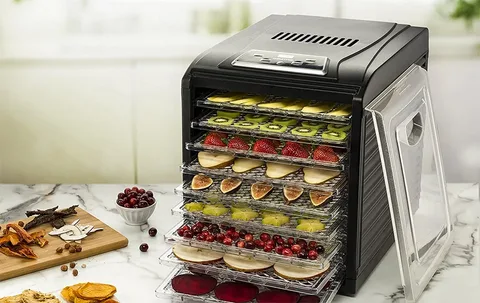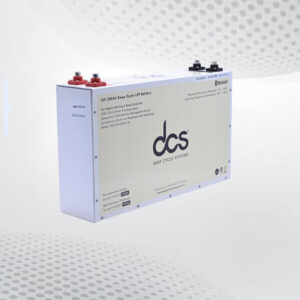If you’re looking to preserve your fruits, vegetables, and meats while maintaining their nutrients and flavors, a food dehydrator is a perfect tool for the job. Food-dehydrators work by removing moisture from food, which helps prevent spoilage and allows for long-term storage. In this blog post, we’ll explore some simple tips for effectively using a food-dehydrator to get the best results.
Understanding How Food-Dehydrators Work
At the core of every food-dehydrator is a simple but effective mechanism designed to draw out moisture from foods, thus inhibiting the growth of bacteria and mound, which often lead to spoilage. This is achieved through the careful application of heat and air circulation. Essentially, a heating element raises the air temperature inside the dehydrator, while a built-in fan promotes the circulation of this hot air around the food trays.
This process ensures that warm, dry air moves continuously, enveloping each piece of food. The warmth of the air absorbs moisture from the food, which is then carried away by the fan, leaving the food dry but still rich in flavor and nutrients. The efficiency of a food-dehydrator hinges on its ability to maintain a consistent temperature that is high enough to expedite moisture removal yet low enough to prevent the cooking of the food.
This balance is crucial as it ensures the food dries thoroughly without losing its valuable dietary content. This delicate process of removing water content under controlled conditions differentiates dehydrated foods from their fresh counterparts in texture and shelf-life, without a significant loss of nutrients. Understanding this process is key to optimizing the use of a food-dehydrator, as it informs decisions on preparation, temperature settings, and drying times tailored to various foods for optimal drying results.
Benefits of Using a Food-Dehydrator
Embracing the use of a food-dehydrator can transform the way you preserve and enjoy your favorite foods.
- Among the numerous advantages, one standout benefit is its remarkable shelf-life extension to a wide array of foods. By effectively removing moisture, dehydrators prevent the growth of bacteria and fungi, which are the primary causes of food spoilage. This allows for the safe storage of foods for months, or even years, without reliance on refrigeration.
- Another compelling advantage is the retention of nutritional value. Unlike preservation methods that can diminish vitamins and minerals, dehydrating food preserves most nutrients, making it a healthier option for snacking and cooking. Additionally, dehydrated foods often concentrate flavors, yielding richer, more intense tastes that can enhance various dishes.
- Dehydrators also present an excellent opportunity to reduce waste. By drying bulk quantities of produce, you can easily manage excess from your garden or take advantage of seasonal sales at the grocery store, transforming perishable items into long-lasting staples.
- Furthermore, the creative possibilities with a food-dehydrator are vast. From crafting homemade jerky to preparing your own fruit leathers or even creating dehydrated meals for camping and emergency preparedness, a dehydrator enables a wide range of culinary experiments and solutions.
Choosing the Right Dehydrator for Your Needs
When venturing into food dehydration, selecting the appropriate dehydrator is pivotal for achieving the desired results. Here are five essential considerations to guide you in choosing the right dehydrator for your needs:
Size and Capacity
Consider how much food you plan to dehydrate at any given time. If you intend to process large batches or have a garden, a larger model with multiple trays will serve you well. Conversely, a compact dehydrator may be more appropriate for smaller quantities or limited space.
Heat Distribution and Airflow
Efficient heat distribution and airflow are crucial for even dehydration. Look for models with a fan and heating element positioned to ensure consistent air circulation across all trays, preventing the need to rotate trays frequently.
Temperature Control
Different foods require different temperatures for optimal dehydration. Select a dehydrator with adjustable temperature settings to give you the flexibility to dry various foods effectively.
Ease of Use and Cleaning
Features such as digital controls, timers, and auto-shutoff can enhance the dehydration process. Additionally, consider models with dishwasher-safe trays or those that are easy to clean manually to save time and effort.
Durability and Warranty
Opt for a dehydrator built to last from reputable brands that offer good warranty coverage. This ensures that your investment is protected, and you can rely on your appliance for years.
Considering these factors will help you find a food-dehydrator that meets your specific requirements, making your food preservation tasks both enjoyable and efficient.
Preparing Food for Dehydration
Proper food preparation before dehydration is crucial to ensure optimal preservation and flavor. Begin by selecting fresh and ripe produce, as the quality of the finished product greatly depends on its initial state. Wash fruits and vegetables thoroughly to remove dirt or pesticides, and peel or slice them into uniform pieces. This uniformity is essential for even drying, as it allows all pieces to dehydrate simultaneously, preventing some from being under or over-dried.
Pretreatment is recommended for fruits prone to oxidation and browning, such as apples, pears, and bananas. Dipping these fruits in a solution of lemon juice and water for a few minutes can help preserve their color and freshness. On the other hand, vegetables like carrots and potatoes may benefit from blanching—a quick boil followed by a plunge into ice water—to retain their vibrant colors and reduce drying time.
Trimming any excess fat can prevent rancidity over time when preparing meats for dehydration, ensuring a longer shelf life for your homemade jerky or dried meats. Marinating or seasoning meat before dehydration enhances flavor and can add a protective layer that helps in the preservation process. Remember the importance of not overcrowding the dehydrator trays. Ample space between pieces allows for efficient airflow and ensures that each piece dries evenly. By adhering to these preparation guidelines, you can maximize the quality and longevity of your dehydrated foods.
Proper Temperature and Timing for Optimal Results
Achieving the perfect level of dehydration is as much an art as it is a science, requiring a keen understanding of the appropriate temperatures and durations needed for different types of food. Fruits, often favored for their sweet, concentrated flavors post-dehydration, thrive at around 135°F. This temperature ensures the fruit dries efficiently without losing its natural sweetness or nutritional value.
Conversely, vegetables are best dehydrated at slightly lower temperatures, around 125°F, which helps preserve their color and essential nutrients. Meats require the highest temperature setting, typically 160°F, to remove all moisture, effectively preventing bacterial growth and ensuring safety for consumption. The variance in drying times is significant and must be carefully managed. Thinly sliced apples might reach their optimal dryness within 6 to 8 hours, whereas beef for jerky could need up to 10 hours or more, depending on thickness and moisture content.
Monitoring the dehydration process is crucial, as over-drying can lead to hard, brittle textures, while under-drying can result in spoilage. To navigate these variables, start by consulting the guidelines provided by your food-dehydrator’s manufacturer, then adjust based on your observations and the specific characteristics of the food you are drying. Remember, patience and attention to detail during the drying process can significantly enhance the quality of your dehydrated foods.
Cleaning and Maintaining Your Food Dryer
Regular maintenance and thorough cleaning are critical for the performance and longevity of your food dryer. After each dehydration session, disassemble the trays and racks for individual cleaning. Use warm, soapy water to gently scrub each component, removing any food particles or residues that might have accumulated during the drying process. A soft-bristled brush can be effective without scratching the surfaces for tougher stains or dried-on food.
Ensure to thoroughly rinse all parts with clean water and dry them completely before reassembling the dehydrator. A soft, damp cloth should suffice to wipe down any surfaces for the dehydrator’s interior. Avoid harsh chemicals or abrasive cleaners, which can damage the unit or leave undesirable residues.
Additionally, check the manufacturer’s guidelines for specific maintenance recommendations or precautions related to the heating element and fan. Keeping the air vents clear of debris is also essential for proper airflow and efficiency, so use a small brush or vacuum attachment to clean these areas as needed. By adhering to these cleaning practices, you can help ensure your food-dehydrator continues to operate effectively, delivering consistently high-quality results with each use.
Storing and Using Dehydrated Foods
After completing the dehydration process, storing the foods correctly is essential to maximize their shelf life. Place the dehydrated items in airtight containers or vacuum-sealed bags to protect them from moisture and air, which can lead to spoilage. Glass jars, heavy-duty freezer bags, or specially designed Mylar bags work well for this purpose. Label each container with the date of dehydration to help keep track of freshness. Keep these containers in a pantry, cabinet, or any space away from direct sunlight and extreme temperatures to preserve the quality and nutritional content of the dehydrated foods.
Incorporating dehydrated foods into your meals and snacks is straightforward and beneficial. Rehydrate fruits and vegetables by soaking them in water before adding them to soups, stews, or smoothies. Dehydrated meats make great additions to homemade trail mix or can be eaten as is for a high-protein snack. Herbs and spices retain their potent flavors and can be used directly in cooking to enhance your dishes. Experimenting with different combinations and preparations can open up a whole new array of culinary possibilities, allowing you to enjoy the fruits of your labor in various delicious ways.
Conclusion
Embracing a food dehydrator can significantly enhance your food preservation efforts and culinary adventures. With the tips provided, you’re well-equipped to dry various foods effectively, ensuring they retain their nutritional value and taste. This method extends the shelf life of your favorite fruits, vegetables, and meats and opens up a new realm of flavorful possibilities. Whether making healthy snacks, preparing ingredients for future meals, or experimenting with new recipes, a food-dehydrator is an invaluable tool in any kitchen. Remember, the key to successful food dehydration lies in understanding the process, choosing the right equipment, and being mindful of preparation and storage techniques.
FAQs
Q: Can different food items be dehydrated together?
A: Absolutely; you can dehydrate various foods simultaneously, provided they share similar drying temperatures and durations. However, it’s crucial to be mindful of strong aromas transferring between foods, which might be undesirable.
Q: What’s the average time required to dehydrate foods?
A: Drying times vary greatly based on the food type, moisture content, and slice thickness. While some items may dry within a few hours, others, especially those with high water content, might take up to 24 hours or more. Frequent checks are recommended to gauge progress.
Q: Is it feasible to dry herbs and spices in my dehydrator?
A: Dehydrating herbs and spices is feasible and highly effective. Spread them on the tray and set your dehydrator to a low temperature. They typically dry within a few hours, retaining much of their original flavor and aroma.
Q: How do I know if my food is adequately dehydrated?
A: Depending on the item, properly dehydrated food should be pliable or crisp. When done, fruits often have a chewy texture, whereas vegetables should be completely dry and brittle. Meats should be tough and leathery with no moisture pockets. Cooling a small piece of food before testing its dryness is important, as warmth can mask the true texture.




